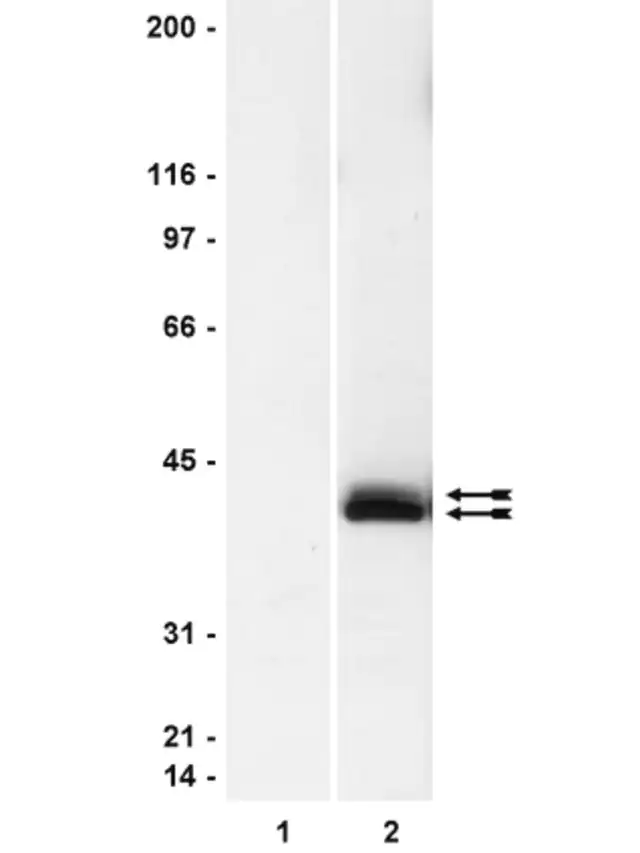您的位置:首页 > 产品中心 > Anti-phospho-MAP Kinase1/2 Antibody
Anti-phospho-MAP Kinase1/2 Antibody

产品别名
Anti-phospho-MAP Kinase1/2 Antibody
Extracellular signal-regulated kinase, Insulin-stimulated MAP2 kinase, MAP kinase 1, MAPK 1, Microtubule-associated protein 2 kinase, extracellular signal-related kinase 1, mitogen-activated protein kinase 3
基本信息
| eCl@ss | 32160702 |
| NACRES | NA.41 |
| General description【一般描述】 | The extracellular signal-regulated kinases 1 and 2 (ERK1 and ERK2), also called p44 and p42 MAP kinases, are members of the Mitogen Activated Protein Kinase (MAPK) family of proteins found in all eukaryotes. Because the 44 kDa ERK1 and the 42 kDa ERK2 are highly homologous and both function in the same protein kinase cascade, the two proteins are often referred to collectively as ERK1/2 or p44/p42 MAP kinase. The ERK1/2 signaling cascade has been shown to be a critical regulator of cell differentiation, cell physiology and neuronal function. Aberrant control of ERK1/2 activity has been implicated in a variety of pathological conditions, including cancer and autoimmune diseases, and efficient study methods are in demand. Extracellular signal/mitogen activated protein kinases (erk/MAPK) are a group of proline-directed serine/threonine kinases that are activated by dual phosphorylation of conserved threonine and tyrosine residues within a characteristic T X Y peptide motif. The mitogen-activated kinases erk1 (MAPK1) and erk2 (MAPK2) acquire full enzymatic activity upon phosphorylation of both threonine and tyrosine residues within the sequence motif T E Y. |
| Specificity【特异性】 | Specific for phosphorylated (activated) Erk1 and Erk2. Antibody recognition requires phosphorylation of both the threonine and tyrosine residues of Erk1/Erk2 and will not interact with the non-phosphorylated form of the proteins. Does not cross react with activated SAP Kinase 1 or 2. |
| Immunogen【免疫原】 | KLH-conjugated phosphopeptide containing the pTEpY motif of Erk1 and Erk2. Clone: 12D4 |
| Application【应用】 | Immunoprecipitation: Use 1-10 μg per immuno-precipitation. Research Sub Category MAP Kinases Detect phospho-MAP Kinase1/2 using this Anti-phospho-MAP Kinase1/2 validated for use in WB, IP, ELISA & IC. Research Category Signaling |
| Quality【质量】 | Evaluated by western blot on RIPA lysates from EGF-stimulated human A431 carcinoma cells. Western Blot Analysis: 0.1-1.0 μg/mL of this antibody detected phospho-MAPK in RIPA lysates from EGFstimulated human A431 carcinoma cells. |
| Physical form【外形】 | Purified mouse monoclonal IgG1k lyophilized from 1 mL 2x PBS / 0.09 % Na-azide / PEG and Sucrose. Reconstitute with 1 mL H2O (15 min, RT) for a final concentration of 100 μg/mL. Format: Purified Thiophilic adsoption and size exclusion chromatography |
| Analysis Note【分析说明】 | Control Included Positive Control Lysate: Catalog # 12-302, EGF-stimulated A431 lysate. Add 2.5 μL of 2-mercaptoethanol/100 μL of lysate and boil for 5 minutes to reduce the preparation. Load 20 μg (20 μL) of reduced lysate per lane for minigels. |
| Other Notes【其他说明】 | Concentration: Please refer to the Certificate of Analysis for the lot-specific concentration. |
| Legal Information【法律信息】 | UPSTATE is a registered trademark of Merck KGaA, Darmstadt, Germany |
产品性质
| Quality Level【质量水平】 | 100 |
| biological source【生物来源】 | mouse |
| antibody form【抗体形式】 | purified immunoglobulin |
| antibody product type | primary antibodies |
| clone【克隆】 | 12D4, monoclonal |
| species reactivity | avian, human, rat, mouse, canine |
| manufacturer/tradename | Upstate® |
| technique(s) | ELISA: suitable immunocytochemistry: suitable immunoprecipitation (IP): suitable western blot: suitable |
| isotype【同位素/亚型】 | IgG1κ |
| NCBI accession no.【NCBI登记号】 | NM_002745 NM_002746 |
| UniProt accession no.【UniProt登记号】 | P27361 |
| shipped in【运输】 | wet ice |
产品说明
| Target description【目标描述】 | 42-44 kDa |
| Storage and Stability【储存及稳定性】 | Stable for 1 year at from date of receipt. |
| Disclaimer【免责声明】 | Unless otherwise stated in our catalog or other company documentation accompanying the product(s), our products are intended for research use only and are not to be used for any other purpose, which includes but is not limited to, unauthorized commercial uses, in vitro diagnostic uses, ex vivo or in vivo therapeutic uses or any type of consumption or application to humans or animals. |




